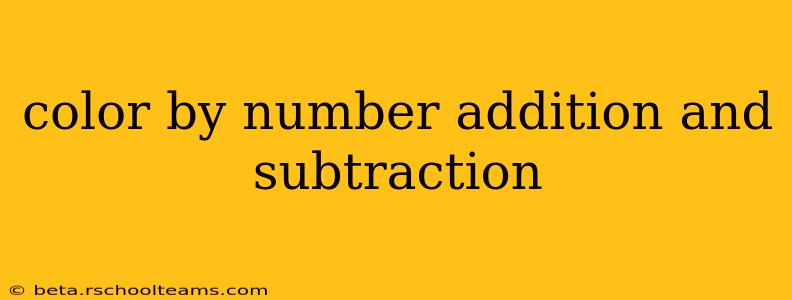Color by number activities are a fantastic way to make learning addition and subtraction fun and engaging, especially for younger children. This method transforms simple math problems into colorful creations, motivating kids to practice their skills while simultaneously enjoying the creative process. This guide will explore the benefits of using color by number for math practice, offer tips for creating your own worksheets, and provide resources for finding pre-made activities.
What are the Benefits of Color by Number Addition and Subtraction?
Color by number worksheets offer several advantages for learning addition and subtraction:
- Increased Engagement: The creative aspect of coloring significantly boosts engagement compared to traditional worksheets. Kids are more likely to complete a task they find enjoyable.
- Visual Learning: The visual representation of numbers and their corresponding colors reinforces number recognition and the relationship between numbers and their sums/differences.
- Self-Checking: Many color by number worksheets allow children to self-check their work. If the colors don't blend correctly or the picture doesn't look right, it's a clear indication that a mistake was made. This promotes independent learning and problem-solving skills.
- Improved Math Skills: Consistent practice with addition and subtraction problems enhances fluency and accuracy. The fun factor minimizes the feeling of pressure associated with typical math drills.
- Develops Fine Motor Skills: The act of coloring within the lines helps improve fine motor skills and hand-eye coordination.
How to Create Your Own Color by Number Addition and Subtraction Worksheets
Creating your own worksheets allows for customization to suit specific learning needs and interests. Here's a step-by-step guide:
- Choose a Simple Image: Select a picture that's easy to color and doesn't have too many intricate details. Simple shapes, animals, or objects are ideal for beginners.
- Divide the Image into Sections: Divide your chosen image into numbered sections. Each section should correspond to a specific addition or subtraction problem.
- Assign a Color to Each Number: Assign a unique color to each number range or solution. For example, all sections with solutions between 1 and 5 could be colored red, 6-10 blue, and so on. You can use a legend to indicate the color-number correspondence.
- Create the Math Problems: Write the addition or subtraction problems in the appropriate section. Ensure the problems align with the child's skill level. Start with simpler problems and gradually increase the difficulty.
- Combine and Print: Combine the image and the math problems into a single worksheet. You can use drawing software or even create a hand-drawn version. Print it out, and you're ready to go!
Where Can I Find Pre-Made Color by Number Addition and Subtraction Worksheets?
Numerous online resources and educational websites offer printable color by number worksheets featuring addition and subtraction problems. A simple web search for "printable color by number addition subtraction worksheets" will yield a wide variety of results.
What are some tips for using color by number worksheets effectively?
- Start Simple: Begin with worksheets featuring easier problems and gradually increase the difficulty level as the child progresses.
- Focus on Understanding: Emphasize understanding the math concepts over speed. Encourage children to show their work and explain their solutions.
- Make it Fun: Use positive reinforcement and celebrate achievements. Turn it into a game or a collaborative activity.
- Adjust to Individual Needs: Tailor the worksheet difficulty to match the child's specific skill level and learning pace.
How can I differentiate color by number worksheets for different learning abilities?
For children who are struggling, start with simpler addition and subtraction facts and fewer sections on the worksheet. You could also pre-fill some of the easier problems to build confidence. For more advanced learners, include larger numbers, more complex problems, or use a larger, more detailed image. You can even incorporate word problems within the color-by-number activity.
What are some alternative activities that use similar principles?
Similar learning methods include coloring pages based on solving other types of math problems (multiplication, division, fractions), matching games based on addition or subtraction answers, and interactive online games featuring colorful rewards for correct answers. The key is to keep the learning engaging and fun!
By incorporating color by number activities into your teaching or homeschooling methods, you can effectively help children master addition and subtraction while fostering a love for learning and creativity. Remember to adapt the difficulty and complexity to suit the individual needs and abilities of each child.
